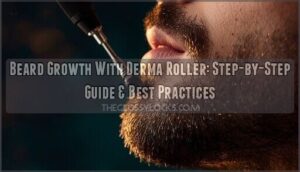This site is supported by our readers. We may earn a commission, at no cost to you, if you purchase through links.
Your beard doesn’t grow unevenly because of bad genetics—it grows where blood flow reaches the follicles most efficiently. That’s why a tool borrowed from dermatology clinics is changing the game for men frustrated with patchy facial hair.
Derma rollers use tiny needles to trigger your skin’s natural healing response, flooding dormant follicles with the nutrients and growth signals they’ve been missing. Clinical studies show an average increase of 91 hairs per square centimeter in just twelve weeks, results that rival prescription treatments.
The technique requires precision, though. Rolling the wrong way or choosing needles that are too long can damage your skin instead of stimulating growth.
Table Of Contents
- Key Takeaways
- What is a Derma Roller for Beards?
- How Derma Rolling Boosts Beard Growth
- Choosing The Right Derma Roller and Needle Size
- Step-by-Step Guide to Using a Beard Derma Roller
- Frequency and Best Practices for Derma Rolling
- Risks, Side Effects, and Precautions
- Frequently Asked Questions (FAQs)
- Conclusion
Key Takeaways
- Derma rolling creates micro-injuries that trigger collagen production and increase blood flow to hair follicles, with clinical studies showing an average of 91 hairs per square centimeter gained in twelve weeks when combined with topical treatments.
- The optimal needle length for beard growth is 0.5 mm, which balances effective collagen stimulation with minimal risk of scarring or skin damage, while proper technique requires rolling in three directions with gentle pressure across systematically divided sections.
- You’ll maximize results by rolling once or twice weekly depending on needle length, immediately applying fragrance-free serums when absorption rates peak at 300%, and allowing 7-10 days for complete skin recovery between sessions.
- Infection prevention requires thorough facial cleansing before treatment and soaking your derma roller in 70% isopropyl alcohol for ten minutes, while you should avoid rolling entirely if you have active acne, eczema, recent cosmetic procedures, or take blood-thinning medications.
What is a Derma Roller for Beards?
A derma roller is a handheld skincare device covered with tiny needles that create controlled micro-injuries in your skin. When you roll it across your beard area, it triggers your body’s natural healing response, which can boost collagen production and increase blood flow to hair follicles.
Understanding how this tool works, what it can do for your beard, and how it stimulates growth will help you decide if it’s right for you.
How Derma Rollers Work
Derma rollers use hundreds of tiny needles to create controlled micro-injuries in your skin. When you roll the device over your beard area, it performs microneedling—a process that disrupts the epidermis and triggers your body’s natural healing response. This action initiates a cascade:
- Micro-needle action creates temporary channels in skin
- Epidermal disruption activates repair mechanisms
- Collagen induction increases protein synthesis by 60–80%
- Growth factors like VEGF and PDGF are released
- Topical absorption improves by over 200%
The result? Enhanced blood flow and nutrient delivery to your hair follicles. These devices promote transdermal drug delivery, enhancing permeation.
Benefits for Beard Growth
When you roll those tiny needles across your face, you’re unlocking several proven advantages. Clinical trials show an average density increase of 91.4 hairs per square centimeter in just 12 weeks—that’s four times more than topical treatments alone. Your patchy coverage transforms as dormant follicles wake up, and product absorption jumps by over 200%, making your beard oils work harder. Derma rolling achieves this by stimulating collagen and elastin production.
| Benefit | What You’ll Notice |
|---|---|
| Faster Growth Speed | New vellus hairs appear within 6 weeks, compared to 10+ weeks without microneedling for beard growth |
| Enhanced Patchy Coverage | 72% of users report filling in thin spots through stimulating beard growth and increasing blood flow to follicles |
| Higher User Satisfaction | 82% experience dramatic improvement using derma roller strategies as beard growth treatments |
Collagen and Hair Follicle Stimulation
All that rolling triggers a biological chain reaction beneath your skin. Microneedling activates growth factors like TGF-β and platelet-derived signals, which spark follicle activation and ramp up collagen synthesis by up to 400%.
Microneedling activates growth factors that spark follicle activation and ramp up collagen synthesis by up to 400%
This healing response floods hair follicles with nutrients, strengthens collagen and elastin fibers by 60–80%, and awakens stem cells in the bulge region—laying the groundwork for thicker, healthier beard growth.
How Derma Rolling Boosts Beard Growth
Derma rolling doesn’t just poke holes in your skin—it triggers a cascade of biological responses that can transform patchy facial hair into a fuller beard. The process works through three interconnected mechanisms that boost your skin’s natural ability to support hair growth.
Understanding these pathways helps you see why this simple tool can make a real difference in your beard density.
Microneedling and Collagen Production
When you roll a derma roller across your skin, you trigger fibroblast activation, which ramps up collagen production and beard growth. This microneedling process creates up to 324,000 microchannels per minute, boosting collagen turnover and follicle stimulation through the Wnt pathway.
- Enhanced collagen synthesis strengthens hair follicles and promotes denser beard growth
- Repeated microneedling sessions compound collagen gains, yielding thicker, firmer skin
- Topical efficacy improves markedly when combined with microneedling treatments
- Studies show 91.4 new hairs versus 22.2 with topical minoxidil alone after 12 weeks
- Collagen-rich environments support deeper penetration of beard growth serums
Increasing Blood Flow to Follicles
Beyond collagen, microneedling dramatically boosts blood circulation to your beard follicles, fueling hair growth with nutrient-rich blood flow. Those micro-injuries improve microcirculation and capillary perfusion, delivering oxygen and essential nutrients directly to dormant follicles.
Studies confirm VEGF stimulation increases after rolling, improving follicle oxygenation. This healthy circulation for hair growth promotes nutrient delivery, creating a favorable environment for stimulating hair growth in patchy areas.
Activation of Growth Factors
Triggering your skin’s repair response unlocks powerful growth factors that transform dormant facial follicles. Microneedling activates the Wnt/β-catenin pathway, signaling stem cells to initiate new beard growth.
You’ll also experience PDGF release and VEGF elevation, which improve blood vessel formation and nutrient delivery.
These growth factors work together with derma rollers to regulate hair follicles’ cycle, accelerating their shift from resting to active growth phases.
Choosing The Right Derma Roller and Needle Size
Not all derma rollers are created equal, and choosing the wrong needle size can set you back instead of moving you forward. The length of the needles determines how deeply they penetrate your skin, which directly affects both safety and results.
Here’s what you need to know about selecting the right tool and using it without damaging your face.
Recommended Needle Lengths for Beards
Choosing the right needle length for your derma roller makes all the difference between safe, effective beard growth and unwanted irritation. For beginners, 0.25 mm needles offer gentle product absorption with minimal scarring risks.
Clinical preferences lean toward 0.5 mm as the ideal length, balancing collagen stimulation and safety.
Experienced users may explore 0.75 mm, but needle size beyond 1.0 mm increases complications considerably.
Selecting Quality Tools
Not all derma rollers deliver on their promises, so needle material matters. Titanium resists dulling 70% longer than steel. Look for CE or ISO13485 certifications to confirm safety standards, and verify the exact needle length on both packaging and the device itself.
Quality brands provide cleaning instructions and replacement guidance, cutting infection risk by 61%. Transparent manufacturers share lab results and origin details, helping you choose tools built to last.
Avoiding Skin Damage
Even premium rollers damage skin when mishandled. Needle size between 0.25 mm and 0.5 mm minimizes skin irritation while stimulating collagen, but rolling technique determines your outcome.
Excessive needle pressure tears epidermis and invites infection—lift and glide instead. Roll horizontally, vertically, then diagonally without twisting to prevent tram-track scars.
Proper scar prevention starts with understanding your skin sensitivity and respecting its healing timeline.
Step-by-Step Guide to Using a Beard Derma Roller
Using a derma roller correctly makes all the difference between seeing results and wasting your time. The process isn’t complicated, but you need to follow specific steps to protect your skin and boost collagen production.
Here’s how to safely incorporate microneedling into your beard growth routine.
Preparing Your Skin and Beard
Before you roll, your skin needs to be clean and ready—think of it as setting the stage for growth. Follow these steps to prepare your beard area safely:
- Pre-roll cleansing: Wash your face and beard thoroughly to remove oils, dirt, and dead cells that could clog microchannels.
- Skin sanitization: Wipe the area with chlorhexidine pads to prevent infection.
- Avoid topicals: Skip retinoids, exfoliants, and irritating products for 72 hours beforehand.
- Assess conditions: Check for acne, rashes, or open wounds—don’t roll over active breakouts.
Always disinfect your derma roller in 70% isopropyl alcohol for at least 30 seconds before use, then rinse and air-dry it.
Proper roller preparation protects your skin health and bolsters your beard care routine. If you’ve recently trimmed, confirm the area is completely healed before starting your session.
Proper Rolling Technique
Once your skin is prepped, technique makes all the difference. Hold your derma roller at a slight angle, apply gentle pressure, and work in systematic sections to ensure uniform coverage—eight passes per zone mimics clinical protocols. Roll longitudinally, vertically, and diagonally for complete stimulation, stopping once you see even pinkness across the beard area.
Best practices for derma rolling emphasize pressure control—you’re triggering collagen, not scraping skin. Needle size selection determines depth, so a 0.5 mm roller requires less force than longer needles. Section your beard into 1 cm² zones for consistent microneedling process coverage, and don’t twist or drag the tool sideways.
| Direction | Pass Count | Purpose |
|---|---|---|
| Longitudinal | 8 passes | Aligns with hair growth pattern |
| Vertical | 8 passes | Cross-stimulates follicles evenly |
| Diagonal | 8 passes | Ensures no gaps remain untreated |
Post-Roll Skincare and Cleaning
After rolling, you’ll see pinkness—that’s erythema resolution beginning. Apply a fragrance-free moisturizer immediately to lock in hydration and speed healing; serum absorption jumps 300% in the first hour, so stick with gentle hyaluronic acid. Skip retinol and acids for 72 hours to avoid irritation.
Proper derma roller cleaning matters, too—soak it in 70% alcohol for ten minutes, then store dry.
Frequency and Best Practices for Derma Rolling
Getting the timing right makes all the difference when you’re rolling for beard growth. Your skin needs adequate recovery between sessions, and pairing the roller with the right products can boost your results.
Here’s what you need to know about frequency, monitoring your skin’s healing response, and making derma rolling work alongside your beard care routine.
How Often to Use a Derma Roller
How frequently should you use microneedling for best beard growth? Using a derma roller once or twice weekly strikes the right balance between stimulation and recovery.
For needle sizes of 0.25–0.5 mm, twice-weekly sessions work well, while 0.75 mm needles require 7–14 day intervals. Excessive frequency disrupts healing and undermines results.
Consistent weekly application aids beard growth while protecting your skin’s integrity.
Assessing Skin Response and Healing
Monitoring how your skin heals reveals whether you’re on the right track. Watch for these signs during recovery:
- Erythema Severity – Mild redness is normal; 70% experience this, resolving within 48 hours
- Recovery Timeline – Full skin repair takes 7–10 days
- Flaking – Days 3–7 mark skin regeneration
- Skin Sensitivity – Longer discomfort signals you need gentler sessions
- Hydration Importance – Moisturizing accelerates healing
Persistent irritation or scarring risks mean you should pause and reassess your technique.
Combining Derma Rolling With Beard Oils
After derma rolling, micro-channels in your skin boost oil absorption rates by up to 60%, greatly enhancing product absorption. Apply beard oil immediately post-treatment for synergistic effects—studies show 82% of users combining derma rollers with beard products saw major beard growth improvements.
Castor oil, biotin, and caffeine are ideal oil types. Stick to 1–2 sessions weekly with proper application timing for best protocols and minimal irritation.
Risks, Side Effects, and Precautions
Derma rolling for beard growth is generally safe, but it does carry some risks you should understand before you start. Most side effects are mild and temporary, but knowing what to expect helps you respond appropriately and avoid complications.
Below, we’ll cover the common reactions you might experience, how to keep your skin protected from infection, and situations where derma rolling isn’t the right choice.
Common Side Effects and How to Manage
You might notice redness or mild swelling within the first day—up to 60% of users do. These side effects generally fade in 48 hours. Dryness, sensitivity, and minor bleeding can also occur, especially with longer needles.
Apply a cold compress right after rolling, then use a fragrance-free moisturizer. If inflammation or bruising persists beyond three days, stop and consult a dermatologist.
Preventing Infection and Irritation
Beyond managing irritation, stopping infection is where most at-home microneedling fails.
Clean your face for 30–60 seconds before rolling, then soak the derma roller in 70% isopropyl alcohol for 10 minutes to neutralize bacteria.
Store your tool in a sealed case, skip harsh serums for 24 hours, and never roll over active acne—these steps sharply reduce inflammation, bleeding, and skin irritation tied to contamination and barrier disruption.
When to Avoid Derma Rolling
You shouldn’t roll if you have active skin conditions like acne, eczema, or rosacea—or if you’ve had recent cosmetic procedures within two weeks. Medications such as blood thinners increase bleeding risks, and improper technique or adverse reactions like persistent redness signal trouble.
Skip derma rolling on sensitive skin or over skin injuries to avoid serious irritation and complications.
Frequently Asked Questions (FAQs)
Can derma rolling fix uneven beard color?
No direct evidence confirms derma rolling to correct patchy beard color. Microneedling stimulates melanocyte activity, potentially improving pigmentation uniformity when combined with topical therapies, but risks post-inflammatory hyperpigmentation if performed incorrectly.
Does beard thickness increase with derma rolling?
Yes, beard density improves with consistent derma rollers through collagen production boost and follicle stimulation. Blood flow enhancement triggers hair count increase—82% of users combining microneedling with growth serums saw significant growth factor activation within twelve weeks.
Are there age limits for derma rolling?
Most dermatologists recommend starting microneedling at age 18, when skin maturity reduces sensitivity and complications.
Minors should seek professional advice and parental consent before using derma rollers due to heightened risks of irritation.
Can you derma roll over beard scars?
You can derma roll over fully healed beard scars to improve texture and stimulate collagen production.
Scar type, needle depth, and treatment frequency affect expected outcomes.
Avoid active acne or inflammation to minimize scarring risks and skin sensitivity issues.
Does diet affect derma rolling beard results?
Nutrition can make or break your hair follicles’ potential. A healthy diet rich in proteins, micronutrients, and healthy fats enhances beard growth by optimizing blood flow, circulation, and nutrient absorption while reducing inflammatory foods impact.
Conclusion
You’ve probably spent more time researching beard growth with derma roller than you spent on your last relationship—and honestly, that’s fair. The science doesn’t lie: controlled injury triggers repair, repair brings blood flow, and blood flow feeds follicles.
You’re not gambling on miracles here. You’re using the same regenerative principles that close surgical wounds and fade scars. Roll with intention, respect your skin’s healing timeline, and give those dormant follicles something to wake up for.
- https://pubmed.ncbi.nlm.nih.gov/23960389/
- https://aventusclinic.com/using-minoxidil-and-derma-roller-together-for-improved-hair-growth/
- https://onlinelibrary.wiley.com/doi/10.1111/jocd.16186
- https://www.droracle.ai/articles/382890/are-beard-rollers-effective-for-promoting-beard-growth
- https://www.healthline.com/health/derma-roller-for-beard











